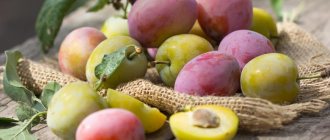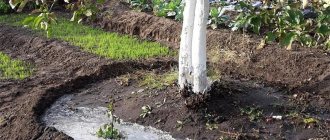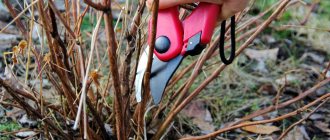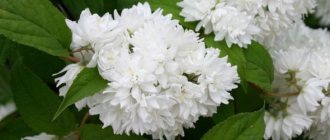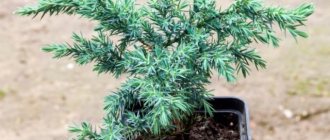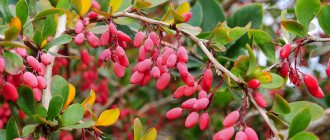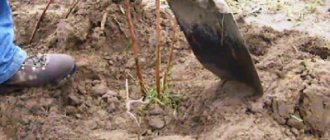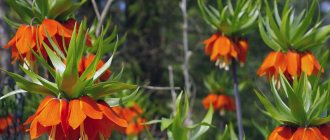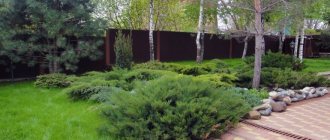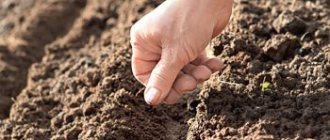Currant
It is best to plant currants at the very beginning of autumn, both in the southern and northern regions. This reduces the risk of infection by pests and diseases, and the roots of the shrub grow better. Spring planting, on the contrary, threatens currants with freezing of the roots. Keep in mind that the rooting period of the plant is 15-25 days, so plan to plant currants about 3 weeks before the expected frost.
Blackberry
Another berry bush that definitely needs to be planted in the fall at the dacha. The amazing ability to grow very quickly throughout the area will provide the owner with a huge amount of delicious berries in the shortest possible time. To avoid dealing with the sharp thorns found on wild forms, you can choose a thornless variety. Some owners combine business with pleasure and use shrubs for a hedge, which is very difficult to overcome due to its density.
Related article:
Cypress varieties
Recently, more and more varieties of this berry bush have appeared with huge fruits, two or even three times larger than the classic ones. In order for the berries to really grow large, as in the description for the variety, you will have to apply fertilizing.
Chestnut
This beautiful deciduous tree can be planted on the site both in spring and autumn. Cuttings or seedlings are planted in the spring, and seeds or seedlings are planted in the fall. The advantages of autumn planting are that the seedling adapts to a new location over the winter, and in the spring it will immediately begin to grow and develop into a strong, symmetrical tree. Autumn planting of chestnuts occurs when the daytime air temperature does not rise above 13-14 degrees.
Planting shrubs with a ball of earth
The earthen lump on the root part of the shrub contributes to a gentler replanting procedure, and during transportation, the underground part of the plant is reliably protected. In this form, the crop can be planted at any time of the year. When purchasing a seedling for autumn planting, it is recommended to find out some points - when the growth period ended, and in what condition the earth ball is.
The earthen lump must be carefully packed in a special net or in damp burlap; it should not crumble. When planting, the net can not be removed from the root part, as it will not interfere with its development and growth. If the earthen coma is in poor condition and its integrity is damaged, it is necessary to use the rules for planting seedlings with bare roots.
Nut
You can plant a nut by sowing seeds in the ground. But if you want to get the harvest a couple of years earlier, then plant a seedling in the fall. This unpretentious tree will not suffer, even if it is not watered after planting. The autumn rains will do this for you. If a harsh winter is expected in the growing region, then it is advisable to insulate the young sprout with covering material.
Dogwood
A southern guest, the fruits of which previously could only be bought. Thanks to the work of breeders, cold-resistant varieties have been developed, and now this berry bush can be planted in any country house. When planting, choose a sunny place so that the fruits are sweet.
It is important to choose an area with calcareous soil. If this is not the case, then you can add lime to the planting hole. Another important point: dogwood does not like high waters, so the distance to ground sources should be at least 1.5 m.
Related article:
Barberry Thunberg Admiration
Birch
Experienced gardeners recommend buying three-year-old birch seedlings and planting them in early autumn. Until the soil temperature reaches +4 degrees, the roots of the birch will produce thin absorbent roots and adapt to the new place of growth. And in the spring, these trees will outstrip those that were planted in the spring. It is also preferable to plant birch seedlings with seeds in the fall.
It’s easier and more profitable to buy high-quality planting material
In the fall, producers sell freshly dug seedlings, which can be purchased at competitive prices, often with seasonal discounts. Such planting material takes root well due to a healthy root system and accumulated nutrient reserves.
In addition, at this time of year, plants are already entering a dormant state, which means that the seedling will not waste energy on growth, the formation of leaves and shoots, which will help it adapt more quickly after planting in a new place.
Honeysuckle
If you have a desire to acquire a fruit-bearing honeysuckle bush, plan to plant it in the fall. Autumn planting of honeysuckle is especially favorable in the southern regions, where winters are not so frosty. The advantages of such planting are that the young seedling is hardened, takes root quickly and in conditions that are comfortable for it. As a result, in the spring such plantings experience rapid growth of foliage and a large number of fruit buds.
Planting seedlings with bare root systems
Rule #1
Seedlings in this form are suitable for autumn planting only after the period of growth and development has completed. This is very important for further wintering. If the growing season continues, the shrub runs the risk of not surviving frost and withstanding the winter cold. In this case, young seedlings will not be saved by either a special covering, protective covers made of breathable material, or a mulch layer.
The end of the bush's growing season can be determined by completely lignified young shoots and well-formed buds on the tops. Some seedlings have a longer growing season; it can last until late autumn. This is typical for those specimens that were grown during the hot and dry summer season.
Rule #2
Shrubs with a taproot or poorly branched root part are not suitable for autumn planting. This applies to such popular crops as hawthorn and hazel, as well as coniferous shrubs. Gardeners recommend planting berry bushes in the fall. The most favorable time for this is the end of October - beginning of November. The berry bushes will have enough time to grow a new root system, which will not happen when planting in the spring months. In the spring, berry plants should direct all their energy to high-quality fruiting, and during spring planting, these forces will be spent on the formation of roots, which will result in a minimal harvest of berries in the coming season.
Saplings with bare roots, brought to temperate climates from warm countries and hot regions, may not take root when planted in the fall and may not withstand winter frosts and a long winter period. It is not recommended to plant such specimens in the fall.
Rule #3
Planting time is of great importance. The optimal time is September and the first half of October. Planting during this period allows the shrubs to take root well before the onset of severe cold and before frosts arrive. The newly emerged roots will have time to strengthen before winter, and then calmly survive various weather conditions. If the root system is fully functioning, the shrub can survive the winter and develop further in the spring and summer seasons, and therefore obtain a high-quality harvest.
If, when purchasing seedlings, the root part is covered with a layer of clay mash (as a protective agent against drying out), then before planting it is recommended to carefully clean it and place the young shrub in a container with water for 24 hours. During this period, the roots will be saturated with a sufficient amount of moisture, which they lost while outdoors.
Raspberries
The bushes of this berry, beloved by many, must be planted before the onset of frost. This shrub has rather delicate roots that are prone to freezing. Therefore, it will be necessary to take care of sufficient insulation of the trunk hole and row spacing. This can be done using any available materials - be it organic or non-woven agrofibres. If you follow these simple conditions, you will be provided with aromatic berries for the next season.
When planting trees and shrubs in the fall, the gardener will spend much less effort on preserving the plants. This is due to nature itself, because autumn is the onset of biological dormancy. And in the spring, trees and shrubs will begin to grow with renewed vigor.
Timing and rules for autumn planting of fruit trees
The gardener needs to choose specific dates independently, focusing on the local climate and weather forecasts. The main thing to take care of is that the seedlings must have enough time to take root before the ground freezes.
However, you should not rush either: the optimal time for planting is considered to be the time when the plants begin to rest. You definitely won’t miss the external sign of such a transition—leaf fall; its completion means the onset of the biological dormancy phase in deciduous crops.
You need to plan autumn plantings in advance. Planting holes are prepared 2-4 weeks before planting, so that the soil has time to settle. When planting, make sure that the root collar of the seedling is at soil level. Don't forget to water the planted plant well.
In areas with harsh winters, it is recommended to mulch the tree trunks generously to additionally protect the root system from frost. It will also be useful to take care of protection from rodents - mice, hares and others.
Planting flowers
In the fall, you can start designing a flower garden. Having chosen a suitable place for planting, you need to dig up the soil here. It is loosened and leveled with a rake. Use the edge of a hoe to mark the pattern of the flowerbed. The lines must be clear and deep, otherwise the seeds will be washed away by heavy rains.
Then you need to draw the beds for future crops. Their depth should be 2 times greater than usual. During the winter the soil sags and cakes.
Using slate, polycarbonate or other suitable materials, the bed is divided into separate sections. A separate sign is stuck into each of them with the name of the flowers that you plan to grow here. The beds are left until stable frosts are established.
It is necessary to prepare the soil for future planting of flowers in early October, when dry weather sets in. There should be a stable above-zero temperature outside. It is necessary to prepare the substrate for filling the holes. While the soil is soft, one part of it is mixed with 2 parts of peat and 1 part of sand. The mixture is stored indoors.
When stable sub-zero temperatures arrive, you can begin planting. There should be no thaws for at least the next half month. Seeds are sown 2 times thicker than in the spring. They are poured into frozen holes, covered with the prepared substrate.
What to do if you didn’t manage to plant it on time
If it happens that you do not have time to plant the purchased plants on time, do not despair. There are different ways to preserve seedlings until spring - choose the one that suits you.
Bury it in the garden
The simplest and most reliable solution is to bury the seedlings in the garden by digging a small trench. The seedlings are placed in it at an angle, sprinkled with soil and additionally covered with spruce branches to protect them from rodents.
Store in the snow
This method is suitable if the ground is already frozen and it is impossible to bury the plants. The seedlings, packaged (to protect them from cold and excess moisture), are buried in snow, which provides them with the necessary constant temperature, protecting them from frost.
But this option should not be used if there are frequent thaws in your area in winter: melt water and an ice crust that forms on the snow after the return of frost will destroy the seedlings.
How to plant trees in autumn
Preparing the pit and planting a seedling
The size of the hole depends on the root system of the seedlings. For stone fruit trees
A pit depth of 60 cm and a diameter of 40 cm is sufficient.
Pome trees
They are planted in holes about 80 cm deep and 60-80 cm in diameter. But if the root system turns out to be larger, it is better to enlarge the planting hole than to bend the roots inward, as this will cause the tree to hurt and develop worse.
Set aside the top fertile layer from the hole separately, without mixing with the rest of the soil. Add drainage to the bottom of the hole - it can be river pebbles, a sand-gravel mixture, or turf soil along with grass (place the grass down at the bottom of the hole - this nutrient layer will rot over time).
itself before planting
If the roots are dry, soak them in a bucket of water for a day. It is also necessary to remove rotten, dry, moldy roots.
Important
while maintaining proportions - the root system in size should be the same or exceed the size of the crown.
It is advisable to install a thin peg next to the young seedling, which will serve as a support from the wind and the plant will take a vertical position, tie the seedling to the peg with a cloth.
We place the seedling in a hole, straighten the roots, fill it with a nutrient mixture (fertile soil is mixed with rotted manure and leaf compost in equal proportions, also add 2-3 kg of wood ash) to the top, but not less than 10-15 cm in height if there is a lack of nutrient mixture. Do not pour water into the hole. Lightly compact the soil around the tree, then make a saucer out of the soil for watering. Water the tree with 2-3 buckets of water.
It often rains in autumn, so watering is not required. Only in dry autumn, water the trees generously 1-2 times a month so that the water saturates the root system.
Important to remember:
the root collar of fruit trees should be 3-5 cm above the ground. To avoid mistakes, place a stick horizontally on the hole and adjust the distance from it.
Return to contents

